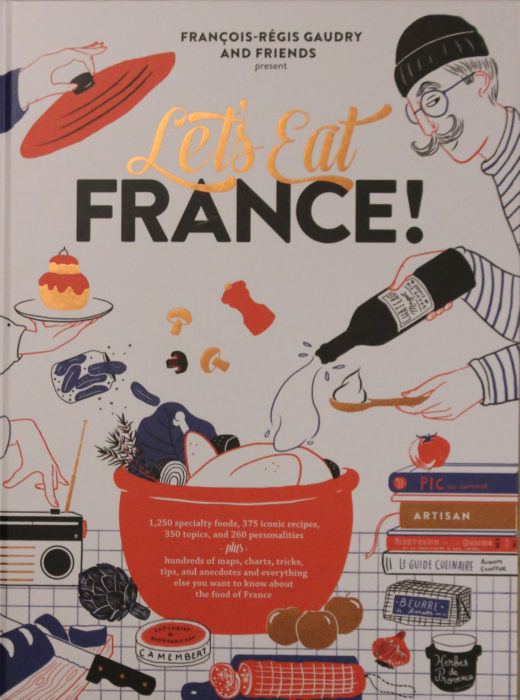
Gargantuan. And great. Let’s Eat France! is a monumental assembly of recipes, facts, and figures.
It is big: 5 ½ pounds, over 400 pages that measure an over-sized 10 X 13 ½ inches. That extra surface area is not devoted to “white space.” No every square inch of space here is used brilliantly.
The front of the book is the best description you could imagine:
“1,250 specialty foods, 375 iconic recipes, 350 topics and 260 personalities
Plus
Hundreds of maps, charts, tricks, tips and anecdotes and everything else you want to know about the food of France”
And that is just what you will find in this amazing book. Do you know what infographics are? Those charts and drawings that provide a visual explanation of a complex topic. Infographics dominate Let’s Eat France!
The book begins with a few pages of History, from sauerkraut in the middle ages, extending to the birth of restaurants in the 1760s, and the 2004 UNESCO designation of Champagne and Burgundy as World Heritage List cultural landscapes. The entry for 1992 notes the birth of La Regalade, a restaurant at the Southern extreme of Paris that you never want to miss.
The Personalities segments are mini-biographies of historic figures like Brillat-Savarin or contemporary stars like Olivier Roellinger and Paul Bocuse [who just passed away]
Those Iconic Recipes include the Croque-Monsieur, Robuchon’s Potato Purée, classic roast chicken, a dozen vegetable soups by dominant vegetable, wild boar in a spice crust, and desserts aplenty. Never fear, as you thumb through this book, there is something sweet very close.
The maps present visual tours of France by ingredient or food: onions, breads, cheese, candies, biscuit [cookies], chickens, cows, pigs, soups, strawberries, citrus, wines, vinegars, jams, honeys, brioche style, mustards, and even knife style. These are the fundamental infographics you want and need to get a quick, encompassing view of France.
There is some linguistics here, too: how to pronounce “g” in French and its roots in the Indo-European words for “swallow.” “Gastronomy” has roots going back thousands of years.
Speaking of gastronomy, there is a map of gastronomy museums in France. Interested in cherry liqueur? There’s a place for you.
What food is more emblematic of France than the croissant. We’ve all heard the stories of its history. Few of us know that the history really, truly reaches back to ancient Egypt. A page here explains it all.
After bread and wine, when we think of France we think of cheese. We can read the saga of Camembert from its birth in 1791 to the recent frenzy about whether to use pasteurized milk. If you think 200+ years is a long time, you can read about the history of Roquefort beginning in 77 AD.
One of the recipes is for classic mayonnaise made by hand. The book shares over 20 flavor variants and speculates on where the name even comes from
You often see “surf-and-turf” on restaurant menus. We know that means steak and lobster. But in France, there are other surf-and-turf combinations, like squid and boudin or veal and oyster. If there was ever proof need that French cuisines is “higher” then it is on this page.
France creates not just recipes but kitchen gear. Did you know they created the vegetable peeler? But only in 1929!
If you drink, you have heard the name “Harry’s Bar.” There are many of them around the world, but the original bar dates from Paris in 1911 and you may well have imbibed one of their creations. You can find two pages of cocktail ideas here, including something called the Bloody Mary.
The book concludes with 15 pages on the Pleasures from the Provinces. Here, province by province, you find the best ingredients and dishes to look for from butchers, farmers, fishmongers, charcuterie, cheese makers, drinks and spirits, and bakeries. It’s something to Xerox for your next trip to France. No, I’m not going to suggest you lug this entire volume along with you. Just, just too massive.
But, I do suggest that you add this book to your library. Keep it handy. And every once in a while, open it up, read a few pages and increase your knowledge of the culinary treasures of France. You’ll be amazed. Let’s Eat France! Is exceptional.
